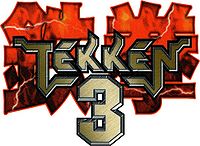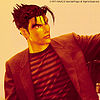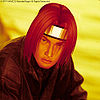Tekken 3
| Tekken 3 | |

| |
| Platforms | Arcade, Playstation |
| Release Date | Arcade
Playstation
|
| Arcade System | Namco System 12 / Sega Model 2 |
| Genre | Fighting |
| Game modes | Single-player, multiplayer |
| Predecessor | Tekken 2 |
| Followed By | Tekken Card Challenge |
| Official site | http://www.bandainamcogames.co.jp/am/vg/tekken3/ http://www.bandainamcogames.co.jp/cs/list/tekken3/index.php |
- Also see (the) Tekken 3 Category.
Contents
Development & Release
Tekken 3 is the third game in the Tekken series. It was developed for Arcades in 1996 and was released on them in March 1997, and for the PlayStation on March 26, 1998 (Japan), October 1998 (United States), and November 1998 (Europe).
Upgrades & Ports
A port of the arcade version of the game was included in the 2005 release of Tekken 5 on the playstation 2 along with Tekken and Tekken 2 as part of the games "arcade history" mode and to commemorate the games tenth anniversary.
Reception
Tekken 3 is considered by many to be the pinnacle of the series, as well as the best fighting game for the Playstation. The game sold over 6,000,000 copies worldwide, which is double than what Tekken 2 ever sold. Critics consider Tekken 3 to be one of the greatest video games of all time. In December 2006, it was ranked #6 on Game Rankings top ten games of all time and on GameSpot's top ten list it was ranked #10.
Story
The King Of Iron Fist Tournament 3 is set 15 years after the The King of Iron Fist Tournament 2. It draws to a close. Jun Kazama comes to the stunning realization that Kazuya's supernatural strength stems from Devil. But she cannot help being drawn to him, propelled by a mystic force beyond her control. Several days later, the final challenger arrives to face Kazuya, the organizer of The King of Iron Fist Tournament 2. In a reprise of the first Tekken tournament, the father and son clash in a cursed blood battle. Eventually, Heihachi emerges, scarred, but victorious, to regain control of the immense Mishima Conglomerate. Heihachi casts the lifeless Kazuya into a fiery volcano.
As Kazuya's body burns, the Devil appears before the pregnant Jun Kazama in a bid to enter the soul of the new life beating within her. But in a desperate struggle for the future of her child, Jun defeats Devil and retires to desolate Yakushima so as to raise Kazuya's son, Jin, alone.
Having regained control of the Mishima Conglomerate, Heihachi sets about to further increase his powers. He embarks on a crusade to win the trust of world leaders by putting wars and conflicts to rest. Using his immeasurable wealth, he forms the Tekkenshu, a mercenary group employed to quell conflicts efficiently. He also takes a strong interest in the well being of developing nations by helping them build agricultural systems that will sustain them. Through Heihachi's efforts, the world appears to be regaining peace.
Jin Kazama is now 15 years old.
Under Heihachi's orders, the Tekkenshu are excavating a Central American archeological site when they discover a mysterious life form. Heihachi orders the creature's capture, but loses contact with the Tekkenshu after a garbled radio message, "... they are all dead... Toshin (Fighting God)?!..."
Upon arriving at the dig, Heihachi finds a field of corpses. Heihachi is wracked by sorrow, but also realizes that the power of the mysterious life form could be the key to his long dormant dream of world domination. To obtain this mysterious power of Toshin, and the world, Heihachi tempts the fates once again...
Within weeks, strange disappearances occur throughout the world. Persons of strong soul, masters of martial arts and other derivative fighting disciplines are reported missing... with no knowledge of their whereabouts.
Jun Kazama instinctively picks up on the dark power encroaching on her life. She has no understanding of what it is, but senses that she has become a target. Accepting her destiny, she tells Jin everything she knows of their haunted past to prepare him for the fateful day she now feels is imminent. She tells Jin to go to his grandfather Heihachi if anything befall her.
Her intuition proves right on a cold, stormy night. Toshin comes to the mountains bringing a chilling, swirling wind. "Run away!" cries Jun. But against his mother's pleas Jin opts to face Toshin for whom he is no match and is knocked unconscious.
When Jin awakens, the house and everything around it is burned to the ground. Jin searches frantically for his mother but she is nowhere to be found.
Jun is presumed dead at Toshin's hand. Honoring her instructions, Jin goes to Heihachi and begs to be trained in order exact revenge. Heihachi, hearing Jin's tale, is convinced that Toshin is after the souls of powerful fighters. To attract Toshin, Heihachi decides to host The King of Iron Fist Tournament 3.
Four years later, on Jin Kazama's 19th birthday, the curtains rise for The King of Iron Fist Tournament 3.
Gameplay
Tekken 3 maintains the same basic fighting system as its predecessors, but brings improvements, such as significantly more detailed graphics and animation, 15 new characters added to the game's roster, and faster and more fluid gameplay. Perhaps the most noticeable change in Tekken 3 is sidestepping, allowing fighters to step "into" or "out of" the background, whereas the element of depth had been largely insignificant in previous Tekken games. Jumping was toned down in Tekken 3, no longer allowing fighters to jump to extreme heights (as was present in previous games) but keeping leaps to reasonable, realistic heights which made air combat more controllable. The improved engine allowed for quick recoveries from knock-downs, more escapes from tackles and stuns, and newly-created combo throws. Tekken 3 was the first Tekken to feature a beat 'em up minigame called Tekken Force. Tekken Force pitted the player in various stages against enemies in a side-scrolling fashion. If the player succeeds in beating the minigame four times, Dr. Bosconovitch would be a playable character (granted that you defeat him first). This was continued in Tekken 4 and succeeded by the Devil Within minigame in Tekken 5. There is also a minigame called Tekken Ball, similar to beach volleyball, where one has to "charge" a ball (hit the ball with a powerful attack) in order to hurt the opponent.
Tekken 3 has only a few returned characters, but mostly new characters. Many characters that were in the original Tekken and Tekken 2 did not return to this game; most do return to Tekken 4 however. Tekken 3 also has some characters which are only in this game, and not featured in another.
Modes
Arcade: This section is empty. You can help by expanding it.
Versus: This section is empty. You can help by expanding it.
Time Attack: This section is empty. You can help by expanding it.
Survival:This section is empty. You can help by expanding it.
Practice:This section is empty. You can help by expanding it.
Tekken Ball: This section is empty. You can help by expanding it.
Tekken Force: This section is empty. You can help by expanding it.
Features
This section is empty. You can help by expanding it.
Roster
* Console Exclusive
Stages
Media
Video Gallery
|
Arcade Opening |
Console Opening |
Embu |
Image Gallery
- Screenshots
- Stages
- Concept
- Artwork
Yoshimitsu in an Orchestra
Paul Phoenix in an Orchestra
Nina Williams in an Orchestra
Ling Xiaoyu in an Orchestra
Lei Wulong in an Orchestra
Forrest Law in an Orchestra
Kuma II in an Orchestra
King II in an Orchestra
Julia Chang in an Orchestra
Hwoarang in an Orchestra
Anna Williams in an Orchestra
Eddy Gordo in an Orchestra
- Promotional
- Manual
Trivia
- If you put the Tekken 3 disc into a CD player (or activate the "CD player" function on your game console), the 2nd track will play. The 2:37 song is called "The King Of Iron Fist Tournament 3: Enter The Tekken."
- "Theater mode" is available after beating the game with all starting characters.
- This is the only tekken feturing two minigames.
- Out of all the Tekken games featuring a Jack model, this is the only one where no Jack is a starting character.
- If you have any saved data from Tekken or Tekken 2 on your memory card, you can view any unlocked FMVs from the games while in Theatre mode.
- This is the first game to have a "theater mode" outside Japan.
- Tekken 3 is mentioned in the Eiffel 65 song, "My Console".
- Some fans believed that the severed head held by Ogre in the Tekken 3 Intro was Jun Kazama's, though this has never been confirmed by Namco.
- In Paul and Bryan's stage, on the wall, a certain piece of graffiti says "Soul Edge", in reference to the Namco's "Soul" series (and possibly the fictional sword itself).
- In Lei's stage, you can see at one point in the background what looks like a transparent Triforce from the Legend of Zelda on a red sign.
- Crow, Falcon, Hawk and Owl, members of the Tekken Force and appearing in the eponymous minigame in this installment, are playable through the use of a cheat device such as Action Replay/GameShark.
- Dr. Boskonovitch and Gon appear as secret characters in the console version of the game, and do not appear in any subsequent titles. Dr. Boskonovitch does however make a cameo in Tekken Tag Tournament's Tekken Bowl mode.
- This is the only Tekken game not to feature Lee Chaolan and Kazuya Mishima.
- This is also the only Tekken game to feature a sound-echoing replay. It only happens on the PlayStation version.
Notes
| Tekken series | |
|---|---|
| Main series | Tekken • Tekken 2 • Tekken 3 • Tekken 4 • Tekken 5 (DR) • Tekken 6 (BR) • Tekken 7 |
| Tag series | Tekken Tag Tournament • Tekken Tag Tournament 2 |
| Other games | Tekken Card Challenge • Tekken Advance • Death by Degrees • Tekken Resolute • Tekken Hybrid • Tekken 3D: Prime Edition • Tekken Card Tournament • Tekken Revolution • Tekken Arena |
| Crossovers | Namco X Capcom • Street Fighter X Tekken • Tekken X Street Fighter |
| Films | Tekken: The Motion Picture • Tekken (2010 film) • Tekken: Blood Vengeance |




























































































